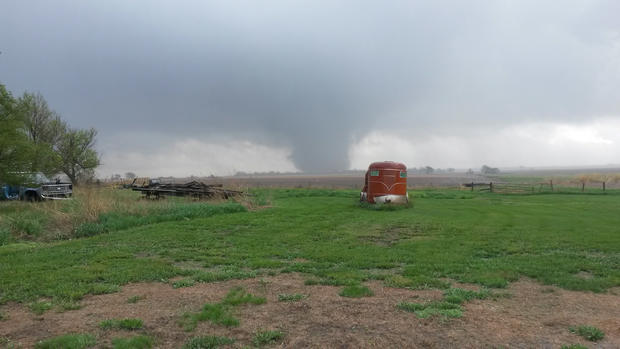Plains states brace for new round of severe weather
MOORE, Okla. -- When spring arrives in Oklahoma and conditions are right for tornadoes, David Wheeler and his family don't take any chances.
Two years ago, a top-of-the-scale twister tore a miles-long path through the Oklahoma City suburb of Moore and turned Wheeler's son's school to rubble. That's when he installed a small underground shelter in his garage. Now the family regularly drills on what to do if the skies turn ominous.
"We've done some dry runs before the spring. I made the kids go down there by themselves, and we've done the same thing with me, the wife and the kids, all together," Wheeler, a fifth-grade teacher whose family has survived two deadly tornadoes, said Friday.
The Wheeler family retreated underground nearly a dozen times Wednesday night, when powerful storms that rumbled across the southern Plains produced more than 50 tornadoes. The menacing clouds had barely vanished before forecasters began warning of another system that could produce even more violent twisters through the weekend in parts of Kansas, Oklahoma and North Texas.
"We're going to see storms that present the risk of a full gamut of severe weather," including large hail, high winds and tornadoes, said Todd Lindley, a meteorologist with the National Weather Service.
The weather service said the greatest risk Saturday was from western Kansas into western Oklahoma, where tornadoes and large hail were likely.
Storms Friday night caused some flooding in Oklahoma. In Shawnee, the Red Cross opened a shelter because officials said a Granada Lake dam was close to being topped after heavy rains, threatening homes in one neighborhood. Officials also closed some roads, including part of Interstate 44 in Tulsa.
In Norman, hail and wind at times caused near blinding conditions, CBS News' Don Champion reports from Oklahoma City.
Baseball-size pellets even knocked out windows at a YMCA building, Champion reports. Crews worked overnight clearing broken glass. Part of the building also flooded during the storm.
The severe thunderstorms marched across the Oklahoma City metro area during the evening rush, Champion reports. At one point, the wind flipped a tractor trailer. Power lines in part of the area were also no match.
To the east, in the town of Luther, lightning sparked a fire.
The Plains states were not the only ones with threatening skies. Twin weather systems stretching from the Carolinas to California produced an unseasonably early tropical storm in the Atlantic and a late snowstorm in the Rocky Mountains.
Snow was also possible in the Nebraska Panhandle, which could get up to 5 inches, and parts of South Dakota, which could receive as much as a foot, according to the weather service.
Heavy rain has swollen Oklahoma creeks and rivers, dramatically increasing the likelihood of flash flooding, Lindley said.
"There's a lot of standing water out there, and these storms are not moving terribly fast, so they're producing a lot of water in some places," he said.
One deluge was so heavy that a 43-year-old Oklahoma City woman drowned after becoming trapped inside her underground storm cellar.
"It just flooded with her in it, and she couldn't get out because it was like a river coming down on top of her," police Sgt. Gary Knight said. "I don't recall it ever raining like that before."
Skylyna Stewart's body was discovered in an older, underground shelter detached from the home.
The 7.1 inches that fell in Oklahoma City was the third-heaviest rainfall for any day on record, dating back to 1890, said state climatologist Gary McManus. Radar data from the part of the city where Stewart's body was recovered indicated as much as 8 to 12 inches may have fallen.
A few miles away in Moore, Kelly Ruffin said she and her family took shelter from the storms in an underground shelter installed in their garage when water from the heavy rains began leaking in.
"It was a heavy trickle at first, and within about 10 or 15 seconds, it was gushing," Ruffin said. "We had to decide if we were going to stay down there and drown or get out, because the sirens were going off. We decided to get out."
Wheeler and his family are not the only ones who sought extra protection after the 2013 tornado that killed 24 people, including seven children who died in an elementary school.
In the two years since, the city has issued more than 3,000 storm shelter permits. City officials estimate that about 40 percent of homes in Moore now have shelters, spokeswoman Deidre Ebrey said.
